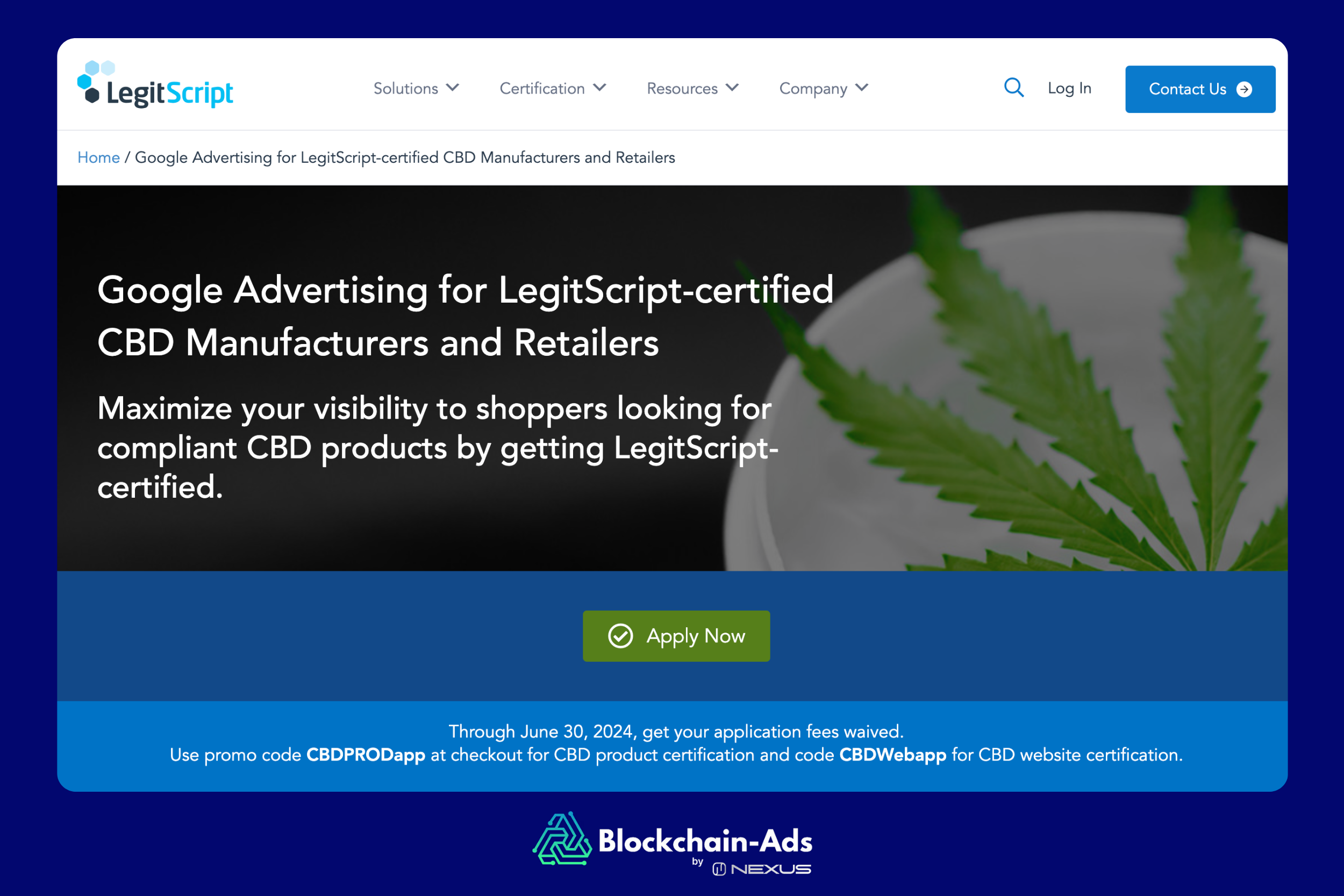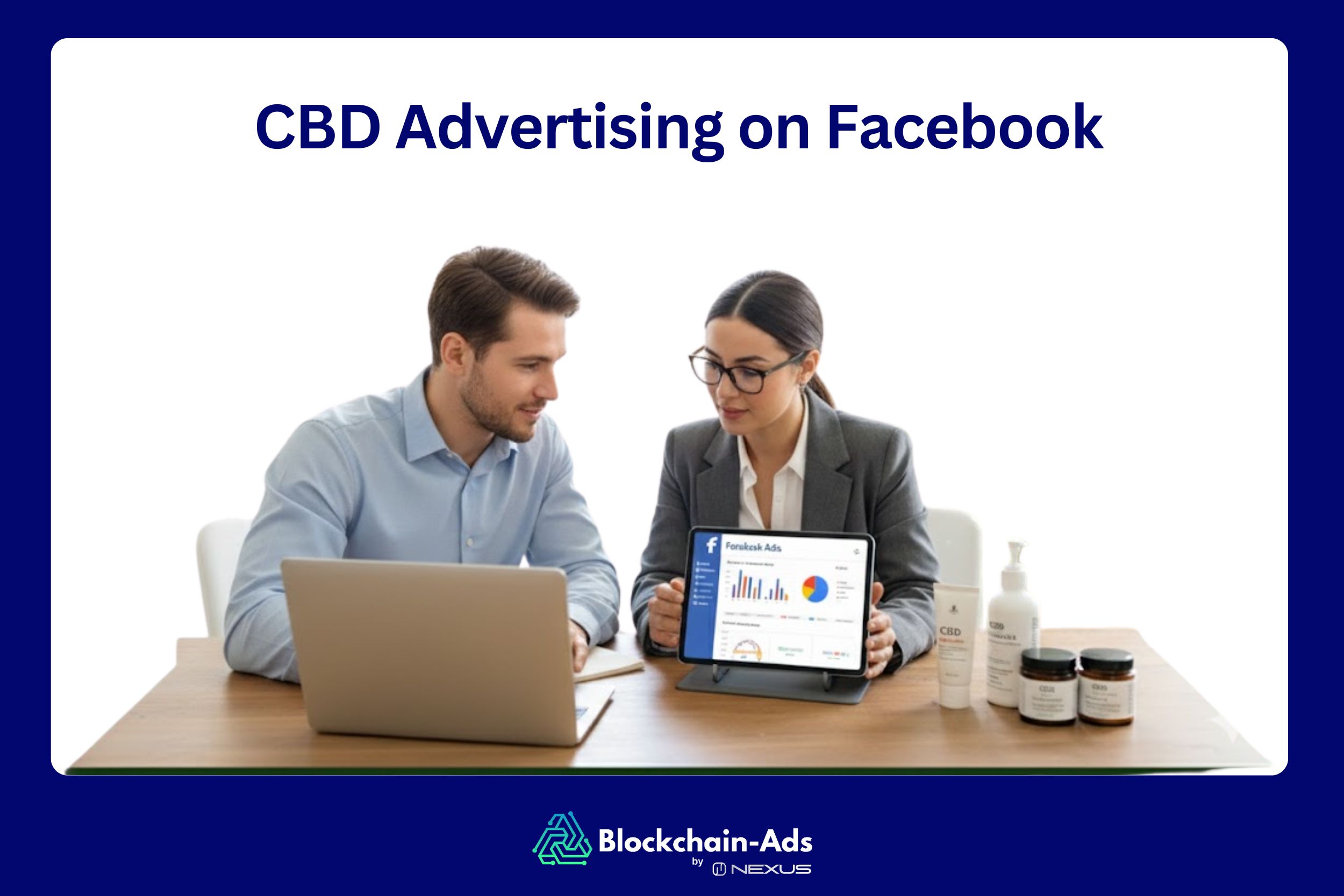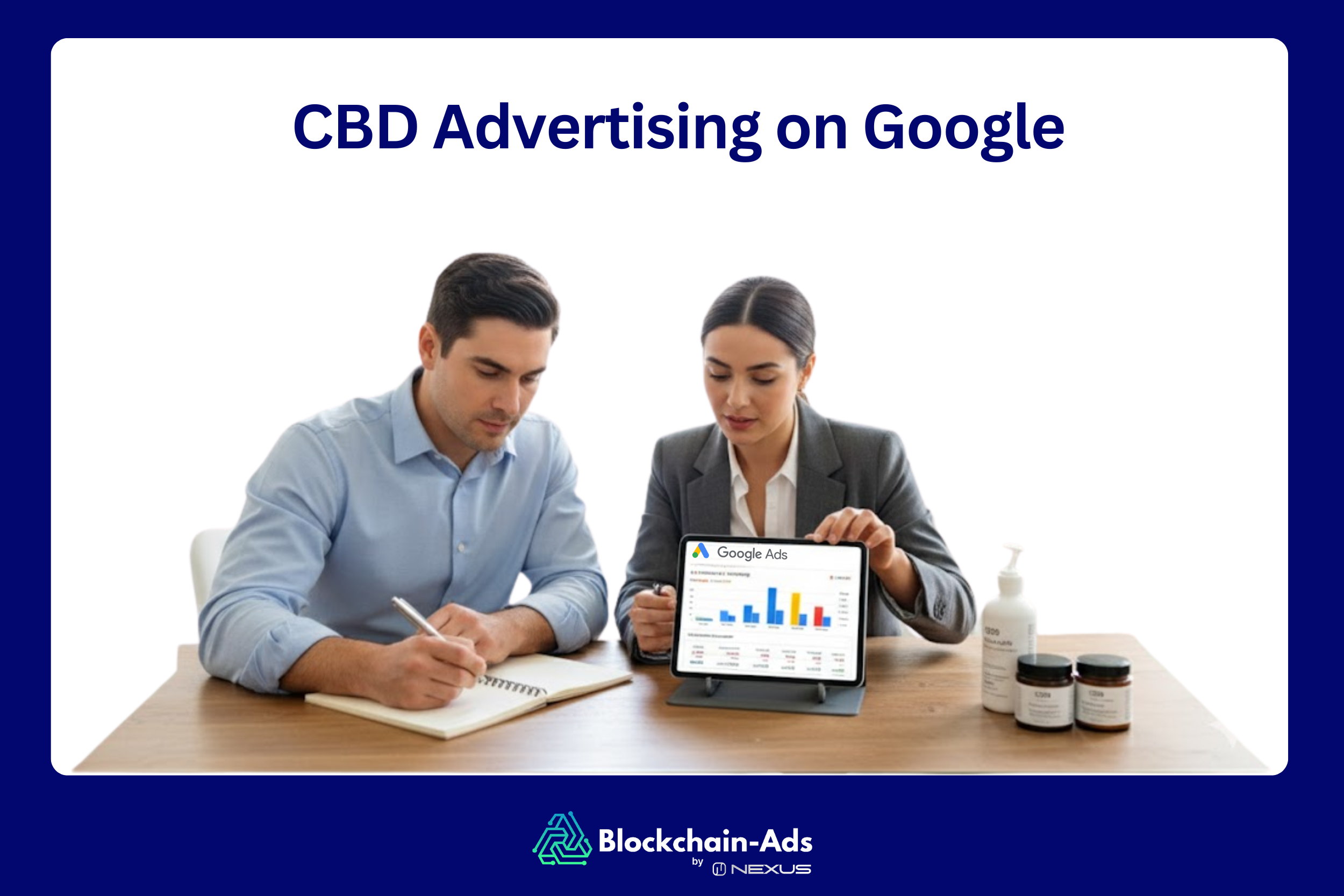How to Run CBD Ads on Google: Complete 2025 Guide
Heading
- Cointelegraph Formula offers various ad formats to 8 million monthly readers across 190+ countries, leveraging its trusted name in crypto.
The global CBD market is expected to hit over $22 billion by 2030, growing at a 16.2% CAGR from now. This kind of growth is impossible to ignore, and for marketers, it’s a clear signal that paid visibility on Google can make a brand successful.
However, advertising CBD on Google isn’t a typical PPC campaign. You can’t launch a few ads, set your daily budget, and expect conversions to roll in. You need LegitScript certification, proof that your products contain less than 0.3% THC, and approval in one of the few markets where CBD Ads are actually allowed.
So, while Ads technically work, the CBD Google Ads policy process is slow, restrictive, and unpredictable. That is why many CBD brands are starting to look to Ad networks specifically created for CBD and other restricted industries.
This CBD Ads guide will walk you through the reality of Google Ads and how to run compliant campaigns. You’ll also find a few alternative ad networks like Blockchain-Ads, which offer a stress-free CBD ad campaign and better targeting.
Why Advertise CBD on Google? – Overview of Google Ads reach, ROI potential, and why compliance matters.

Google is undoubtedly one of the world’s biggest gateways to online discovery. Every day, an estimated 14-16.4 billion searches happen on Google. And thousands of those include terms like ‘’best CBD oil,’’ ‘’CBD for sleep,’’ or hemp gummies near me.’’ That’s an awesome opportunity sitting right in front of CBD brands if you can tap into it legally and effectively.
The good thing about Google Ads is its intent-based targeting. Unlike social media ads that interrupt users mid-scroll, Google reaches people who are actively looking for solutions. That means every click has built-in intent. And the result is a higher potential return on ad spend (ROAS) compared to most other digital channels.
In fact, businesses using Google Ads typically earn $2 in revenue for every $1 spent (Demand Sage). For compliant CBD brands, that ratio can even be higher when campaigns are optimized for long-tail keywords and localized search queries. CBD brands using Blockchain-Ads have achieved even better results, like CBDfx's which acquired 42,000 customers without geographic restrictions, achieving a 6.3x ROAS campaign.
But compliance matters more than creativity. Google only allows hemp-derived CBD ads that meet strict legal and certification criteria. For example, they must contain less than 0.3% THC, be sourced from hemp grown under U.S. Farm Bill guidelines, and be pre-approved through LegitScript certification. Without compliance certification, your ad copy will never go live. To avoid these compliance roadblocks entirely, many CBD advertisers are switching to regulated industry ad platforms that specialize in CBD advertising.
Google Ads Policy for CBD Products
Since January 2023, Google has been running a limited pilot program that basically allows some CBD advertising. But this CBD Ads January 2023 update is only under very specific conditions. So before you consider starting to set up a campaign, you must understand what’s actually allowed. You also need to know where you can advertise and which mistakes could get your account suspended.
Allowed CBD Products – Hemp-derived topicals with ≤0.3% THC only.
The good news is that you can run Google Ads for hemp-derived topical CBD products. These are things like cream, balm, roll-ons, and lotions, as long as they contain no more than 0.3% THC. That’s the legal threshold under the 2018 Farm Bill, and Google sticks to it seriously.
Your product labels and landing pages must clearly state that the product is hemp-derived and THC-compliant. Google wants full transparency.
Geographic Restrictions – Ads only in California, Colorado, Oregon, New Mexico, and Puerto Rico.
Even if your product meets the criteria, you can’t advertise it everywhere. Google only allows CBD ads to run in California, Colorado, Oregon, New Mexico, and Puerto Rico. Oregon and New Mexico were added to this list in mid-to-late 2024, expanding the program slightly but still keeping it highly restricted.
These areas have well-defined state-level hemp programs and looser regulations. This makes it easier for Google to control and monitor CBD Ad compliance. If you try to run your campaign in any other U.S. state, Google’s system will automatically block your ads from showing. Google continues to treat this as a limited pilot program, meaning global rollout remains restricted and there is no indication of when or if broader geographic expansion will occur.
Prohibited Products & Claims – Ingestibles, health claims, imagery rules.
Google does not allow ads for CBD ingestibles. These include oils, tinctures, gummies, capsules, or anything meant to be swallowed.
You also can’t make any medical or therapeutic claims even if your product has many five-star reviews saying it helps with pain, anxiety, or sleep. Phrases like ‘’relieves stress, ‘’reduces inflammation,’’ or ‘’supports better sleep’’ are considered health claims and will get your ad pulled immediately.
For images, avoid showing people applying CBD to their skin in a way that suggests pain relief or medical treatment. Keep it clean, lifestyle-focused, and neutral.
Comparison Table: Allowed vs. Prohibited CBD products on Google Ads
Certification Requirements
Before you can even think about running CBD ads on Google, there’s a two-step approval process you have to go through: LegitScript CBD certification and Google Ads CBD certification.
LegitScript Certification – Process, cost, documentation needed.
Google won’t even bother looking at your application until LegitScript gives you the green light. You start by applying through the LegitScript website. The site will request documents such as a business license, product lab reports, website URL, and product packaging. They’ll go through it all to ensure that your products are truly hemp-derived, contain no more than 0.3% THC, and your marketing material doesn’t make any medical claims.
You’ll still need to prove that your manufacturing and labeling practices are transparent and compliant. Then there’s the CBD Ads costs. Most brands end up paying around $4,000 per year for certification. This, of course, depends on the number of products and the complexity of the review. Once approved, you’ll receive a LegitScript certificate, which you’ll submit to Google later in the process.

Google Ads CBD Certification – Application steps after LegitScript approval.
This part is much faster. You’ll submit your LegitScript credentials directly to Google. This is usually through a short form in your Ads account or by contacting Google Ads support. Google will verify your LegitScript ID, check your website again for compliance, and confirm that you’re only promoting eligible topical CBD products within California, Colorado, or Puerto Rico. Once you meet Google Ads CBD requirements, your account will be tagged as a verified CBD advertiser. Once that’s done, you can go ahead and start creating and running campaigns.
Step-by-Step Guide to Launching Your First CBD Ad
Running CBD ads on Google is easy once you know the sequence. Here’s what the process looks like.
Step 1: Audit Your Product & Landing Page
Audit everything from your products, website, and landing page. Usually, Google’s approval depends on your entire brand being clean. In this regard, make sure:
- Your CBD products are hemp-derived and contain no more than 0.3% THC.
- You’re only selling topical items like creams, lotions, and balms. Products like oils, gummies, or tinctures will be rejected.
- Your website clearly shows third-party lab reports (COAs) for every product.
- Your landing page doesn’t make any medical or therapeutic claims like ‘’reduce anxiety’’ or ‘’treat pain.’’
Step 2: Apply for LegitScript Certification
Head to LegitScript’s website and start the CBD Ad certification process. It takes 2-4 months, depending on how prepared you are. In this step, you’ll need to submit documentation like business registration, manufacturing process, product test results, and label designs. Also, ensure that your COAs are recent, typically within 12 months, and come from accredited labs. Finally, your certification will cost around $4,000 or more per year.
Step 3: Submit Google Ads Certification
Once you’re cleared by LegitScript, you’ll need to submit that certificate to Google via your Google Ads account or through support. Google will run its own checks to confirm your LegitScript ID, review your ad destination, and verify your target locations. If everything checks out, your request will be approved.
Step 4: Set Up Campaign Targeting & Budget
Now, set up your campaign. Pick one product line (like a CBD lotion or roll-on). Then, set realistic goals and a budget. A good starting point for most small CBD brands is around $50-$100 per day until you have data to optimize. For CBD Ads geographic targeting, focus on:
- Location: CA, CO, or PR
- Audience: Adults aged 25+ who show interest in wellness, recovery, or natural skincare.
- Keywords: Stick to safe terms such as ‘’hemp cream’’ ‘’hemp skincare’’.
Step 5: Create Compliant Ad Copy & Assets
The copy you make has to be clear, compliant, and creative. Avoid medical or therapeutic claims. Never say ‘’cure’’, ‘’treat’’, or ‘’heals.’’ Focus on benefits like ‘’calming relief’’, or ‘’nourishing skincare.’’ Also, use clean and professional images. Avoid photos that show ingestion or body parts being treated. Example of a compliant copy can be ‘’Discover hemp-infused skincare made from U.S.-grown hemp. Third-party tested. Available in California.’’
Step 6: Monitor Performance & Maintain Compliance
Check the CBD Google Ads policy alerts daily. Track CTR, conversions, and disapproval. Also, keep COAs current and save all certification emails. If Google flags something, you’ll want documents ready to appeal, or save yourself the stress by opting for a DSP that offers blockchain-verified attribution for transparent performance tracking.
Troubleshooting Disapprovals & Appeals
Getting your CBD ads disapproved by Google happens a lot, even to experienced advertisers. Even though, as of 2024, Google has improved its Policy Enforcement Automation, which has led to faster review times and fewer false disapprovals for compliant CBD brands. The good news is that it isn’t the end of the world. What really matters is how fast you fix it and how well you document everything.

Editing Your Ads to Comply
After receiving the notice, read the exact CBD Google Ads policy violation in your dashboard. Usually, Google will tell you what triggered it. The most common issues are medical claims, THC confusion, or missing lab test info. Edit the ad and your landing page side by side. After that, resubmit the ad for review.
How to Appeal a Disapproval
If you’re sure that your ad meets every rule and it’s still rejected, use the appeal button directly in the Ads interface. Keep your message short and factual. Ensure you mention your LegitScript CBD Ad approval ID, Google Ads CBD certification, and COA documentation. CBD Ads appeal is usually reviewed within a few business days.
Avoiding Future Suspensions
The best defense is prevention. Keep all certifications up to date, refresh COAs regularly, and never run unapproved CBD ingestibles. Also, use a shared doc to track all your ad copy, images, and compliance checks. Google will never suspend your account without warning. You’ll first receive a policy alert. Respond to it quickly and stay transparent.
Alternatives to Google Ads for CBD Marketing
Even though Google Ads has opened its door slightly to hemp-derived CBD, the restrictions are still tight. That’s why many brands are considering CBD alternative advertising channels that allow them to advertise freely and reach real audiences. Here are a few CBD digital marketing options.
CBD-Friendly Ad Networks – Blockchain-Ads, Leafly, Weedmaps, programmatic options.
If you want to run paid ads without worrying about rejection, go to CBD Ad networks where your audience already is. Blockchain-Ads and other platforms, such as Leafly and Weedmaps, are made for cannabis and CBD advertisers. They actually understand the industry, accept compliant creatives, and can even help with wallet-based or location targeting. Programmatic networks are also an option. They let you place your ads across hundreds of vetted sites while controlling who sees them and how much you spend.
SEO & CBD Content Marketing – Organic traffic strategies.
If you want to play a long game, then nothing beats organic traffic. You can post helpful content like blog guides, product breakdowns, and real customer stories. These CBD marketing strategies can slowly pull in a steady stream of visitors who are already curious about CBD.
Social Media & Influencer Partnerships – Platforms and CBD Ad best practices.
Social media platforms can be tricky. However, they’re powerful when handed strategically. Instead of direct product ads, share lifestyle content, customer stories, or wellness tips. Also, partner with influencers who genuinely use and believe in CBD. They can help speak authentically about their experience, and this makes it feel real, and the audience can tell.
Email & SMS Marketing – List building and compliance.
Email and text marketing let you speak directly to people who already care about your products. If you have a customer list, message them and always follow privacy and consent laws. Keep it simple—product updates, wellness tips, or exclusive deals
Compliance Best Practices – Ongoing policy monitoring, truthful messaging, record-keeping.
If there’s one golden rule in CBD advertising, it’s staying honest, updated, and organized. Here’s what really matters:
- Keeping up with the CBD Google ads policy updates
- Be honest in your messaging
- Detailed record-keeping
- Don’t overpromise
- Train your team to understand CBD advertising rules
Frequently Asked Questions
Can you advertise CBD products?
Yes. Only advertise hemp-derived topicals with ≤0.3% THC in CA, PR, and CO Ingestible CBD products like oils, gummies, and tinctures are strictly prohibited. You must also obtain LegitScript certification and Google Ads approval before running any campaigns.
Does Google SEO allow for hemp?
Absolutely. The CBD SEO strategy is unrestricted. Publish high-quality and informative content to rank organically. Focus on educational blog posts, product guides, and customer testimonials that provide value to your audience. Unlike paid ads, organic search has no geographic limitations, so you can target readers nationwide.
How do I advertise CBD on Google?
You can advertise on Google by staying compliant. Then, get LegitScript CBD certification and be approved by Google Ads. The process takes several months and costs around $4,000 annually for LegitScript certification. Make sure your products meet all requirements, including displaying third-party lab test results and avoiding any medical claims in your ad copy.
Qualify and get acess to Blockchain-Ads
Lorem ipsum dolor sit amet, consectetur
Quick Definition

Talk with some of our current partners
View all success stories

Reach 12M+
Engaged Web3 users across 10,000+ websites and 37 blockchains.






.png)





.png)
